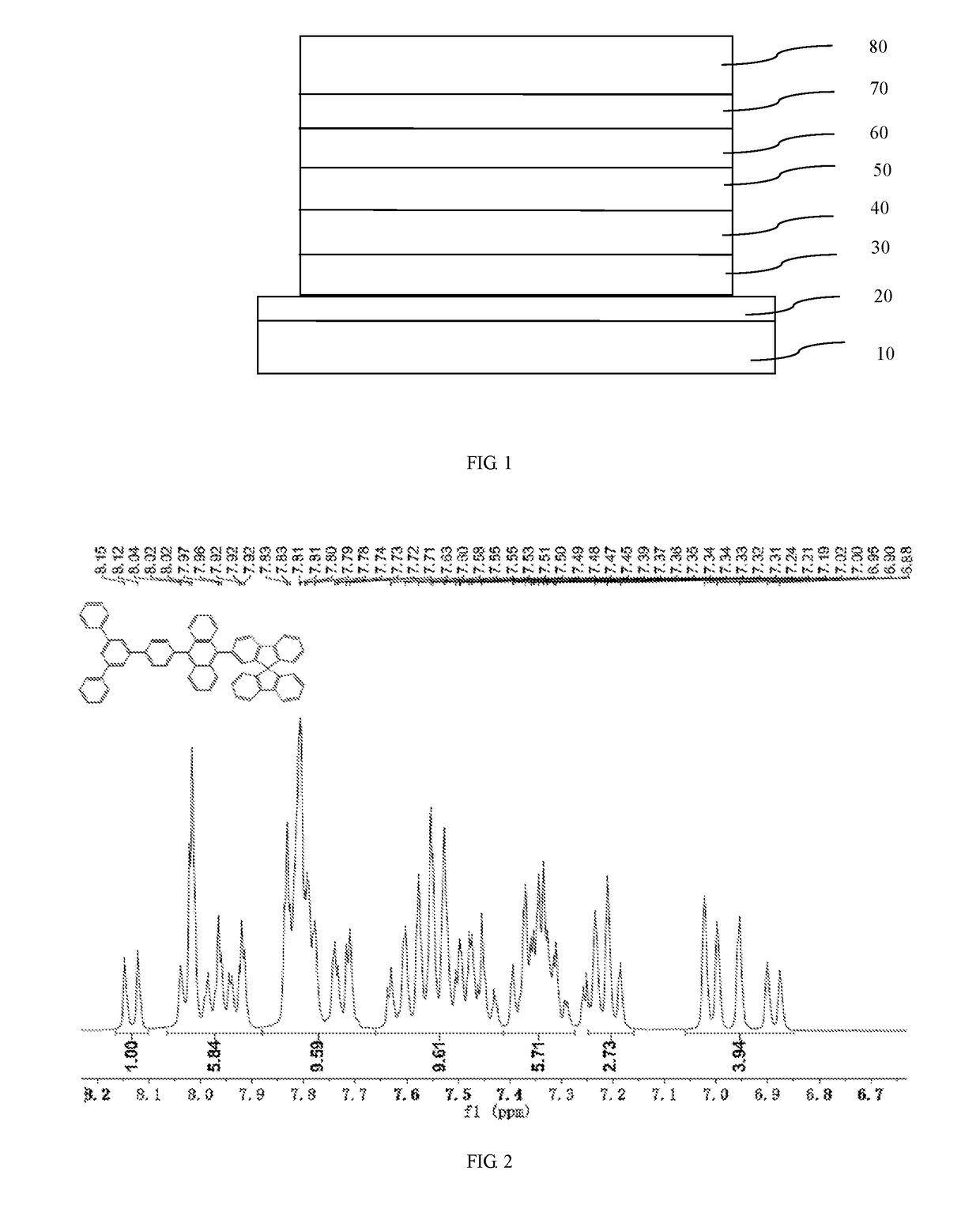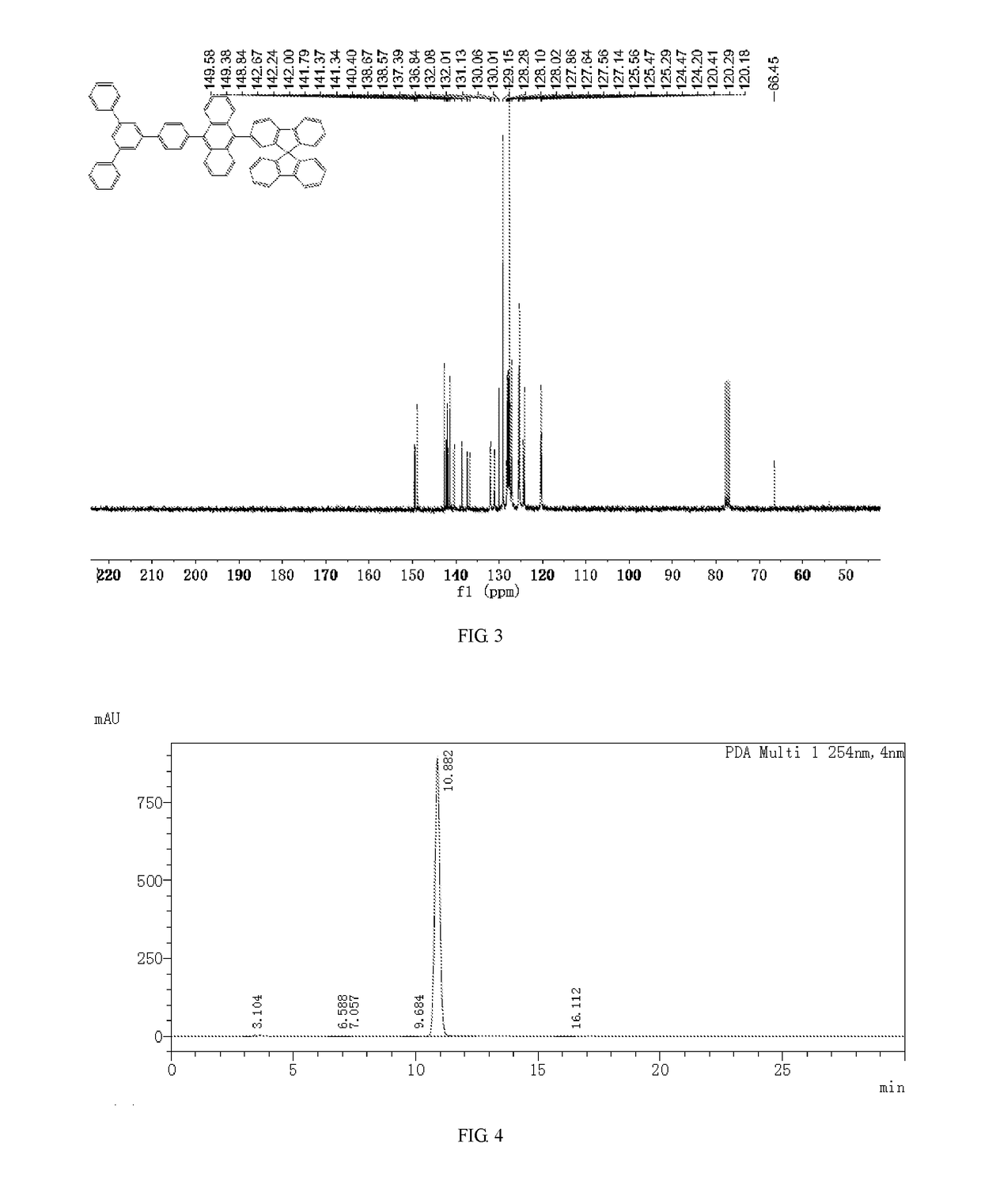Organic electroluminescent device
- Summary
- Abstract
- Description
- Claims
- Application Information
AI Technical Summary
Benefits of technology
Problems solved by technology
Method used
Image
Examples
embodiment 1
[0035]
Synthesis of Intermediate 1c
[0036]Add 1a (240.00 g, 0.88 mol), 1b (496.32 g, 1.76 mol), Pd(PPh3)4 (20.35 g, 17.60 mmol), potassium carbonate (302.52 g, 2.20 mol), toluene (2400 mL), pure water (1200 mL) to a reaction flask. Start to heat after extracting air for three times, and when the reaction solution temperature reaches 95-105° C., maintain it for 8-12 h; take samples for TLC and HPLC, to completely react. Stop heating and cool down to 20-30° C., perform suction filtration to separate the organic layer from filtrate. Extract the aqueous layer with ethyl acetate, combine the organic layer, then wash with water, dry by anhydrous magnesium sulfate, and perform suction filtration, to get the filtrate.
[0037]Concentrate the filtrate to get a dark yellow solid crude product. The crude product is recrystallized from petroleum ether to get an off-white solid product, with a yield of 90% and a purity of 95%.
Synthesis of Intermediate 1d
[0038]Add 1c (302 g, 0.78 mol), B(OEt)3 (142 g,...
embodiment 2
Synthesis of Compound 3
[0045]
[0046]Add 1g (9.5 g, 16.92 mmol), 3a (7.25 g, 30.46 mmol), Pd(PPh3)4 (1.5 g, 1.3 mmol), potassium carbonate (5.84 g, 42.3 mmol), toluene (150 mL) and pure water (75 mL) to a 500 ml three-necked flask. After extracting nitrogen for three times, reaction occurs at 105° C. The time of reaction stop is around 12 h, which is detected by liquid phase. The reaction solution is earth yellow of catalyst at the beginning, slowly turning into a yellow solution. After reaction stops, the upper layer is bright and light yellow, and the lower layer is water. After reaction stops, filter the solution, wash the filter residues with ethyl acetate until no product in the residue, then collect the filtrate, spin-dry, to separate out a large amount of off white solid. Collect the filter residue to dry, to get the target product, with purity of 98%; after vacuum sublimation, gray-white solid powder with purity of 99.7% is obtained.
[0047]1H-NMR (300 MHz, CDCl3) δ 8.1-8.2 (d, ...
embodiment 3
Synthesis of Compound 89
[0048]
[0049]Add 1g (10.0 g, 17.8 mmol), 89a (7.1 g, 19.6 mmol), Pd(PPh3)4 (432.2 mg, 0.35 mmol), K2CO3 (6.14 g, 44.5 mmol), toluene (300 mL) and water (150 mL) successively to a reaction tank. After deoxygenization of the device and introduction of nitrogen, heat to 100° C. for reaction overnight, apply to the plates at a ratio of DCM:PE=1:5. The product gives out intensive blue light under UV light at 365 nm wavelength, with the Rf value at about 0.2. Perform suction filtration with the reaction solution, wash the filter cake with ethyl acetate (100 mL) twice and separate. Extract the aqueous layer with ethyl acetate (100 mL) once, combine the organic layers, then wash the organic layer once with water (200 mL). spin dry to remove the solvent. The crude product is recrystallized from 120 ml DCM / MeOH, then suction filtration is performed to get 13.1 g yellow solid powder, with a purity of 98.7% and a yield of 92.2% yield. After vacuum sublimation, a slight ye...
PUM
 Login to View More
Login to View More Abstract
Description
Claims
Application Information
 Login to View More
Login to View More - R&D
- Intellectual Property
- Life Sciences
- Materials
- Tech Scout
- Unparalleled Data Quality
- Higher Quality Content
- 60% Fewer Hallucinations
Browse by: Latest US Patents, China's latest patents, Technical Efficacy Thesaurus, Application Domain, Technology Topic, Popular Technical Reports.
© 2025 PatSnap. All rights reserved.Legal|Privacy policy|Modern Slavery Act Transparency Statement|Sitemap|About US| Contact US: help@patsnap.com



